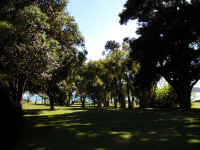
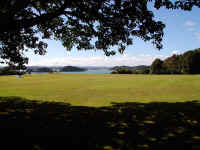
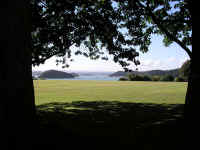
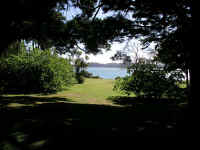
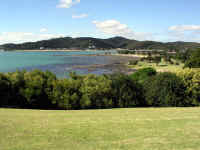
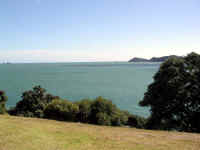
Our day started with a visit to Waitangi (why-tang-ee). This historic site is where the Treaty of Waitangi was first signed in 1840 between the Maori Chiefs and the British Crown. The treaty has become the basis for life in New Zealand because it guarantees the rights of both Maori and non-Maori. It is an agreement between two peoples to live and work together in one nation. Lord and Lady Bledisloe purchased the estate in 1932 and gave it in trust to the people of New Zealand.
The grounds and views of the harbor:
 |
 |
 |
 |
 |
 |
The flagpole in front of the Governor General's residence which marks the site of the signing of the treaty.
Governor General's home. Unfortunately the gardens do not show up well
in the photograph. Note how the timbers above the door were assembled
with wooden pins. The walls were filled with close fitting brick to act as
an insulator (removed to show the wood construction). The building was built in Australia, disassembled and
reassembled on this site for the Governor General in 1833 to '34.
This is a traditional Maori meeting house (Te Whare Runanga) opened in 1940 during the Treaty Centenary Celebrations. It symbolizes the Maori involvement in the signing of the treaty and the life of the nation. You will notice that many of the faces in Maori carvings have bulging eyes made from Paua shells and extended tongues. The figures are distorted because the Maori believe that only God can make a perfect human figure.
The carvings represent tribal ancestors. The woven panels are made from
reeds.
The Maori people came to New Zealand in seven wakas (boats). The largest of them held over 100 people. The people in each of the seven boats formed the basis of one of the original seven tribes to be established in New Zealand. All New Zealand Maori can trace their ancestry back to one of these wakas.
This boat in the photos was constructed using the same methods used in the construction of the original seven boats. It is 35 meters long and requires at least 76 paddlers to handle it safely in the water.
This Waka was constructed from three logs that were joined by two lashed joints
(lower right photo). To increase the strength, the joint did not go straight
across the boat. It starts at the top of each side, runs down a short
distance and then diagonally (towards us in the photo) and then across to join
the cut on the other side.
Joan and I sitting on the stump of one of the trees used to construct the
Waka shown above.
In the afternoon we elected to go on a boat cruise out to "The Hole in The Rock" which is a rock formation off the coast in the Bay of Islands area (Fullers Cruse Web Site).
Elaine, Joan and I on the boat going out to "The Hole in The Rock"
Motukokako Island -- the hole in the rock
Just as our boat was maneuvering into position to go through the hole in the
rock, a pod of about 4 dolphins was spotted near by.
Cape Brett Lighthouse, the last manned lighthouse in New Zealand. Now
automated. The lighthouse keeper's home can now be rented by vacationers.
The area is popular for sailing ...
We came across this unusual sight -- a floating garbage collection point
anchored in a bay popular with boaters for picnics and camping. The
'Rubbish Boat' is periodically replaced with an empty one and the full one is
towed to shore to dispose of the contents.
We spent some time walking the island of Urupukapuka where we came upon a huge Pohutukawa (pa-who-ta-cow-a) tree, also known as the New Zealand Christmas tree because it blooms near Christmas.
The last photo shows our tour boat in the cove.
The small town of Russell, across the bay from where we were staying in
Paihai.
Since this evening was New Year's Eve, a special evening banquet was enjoyed by our group at the hotel. We had planned to stay awake to be the first to usher in the New Year and hopefully catch a glimpse of the town's midnight fireworks display. However, since we had so much sun and sea air earlier in the day, we were sound asleep by midnight. Happy New Year to All!
Next day: January 1st